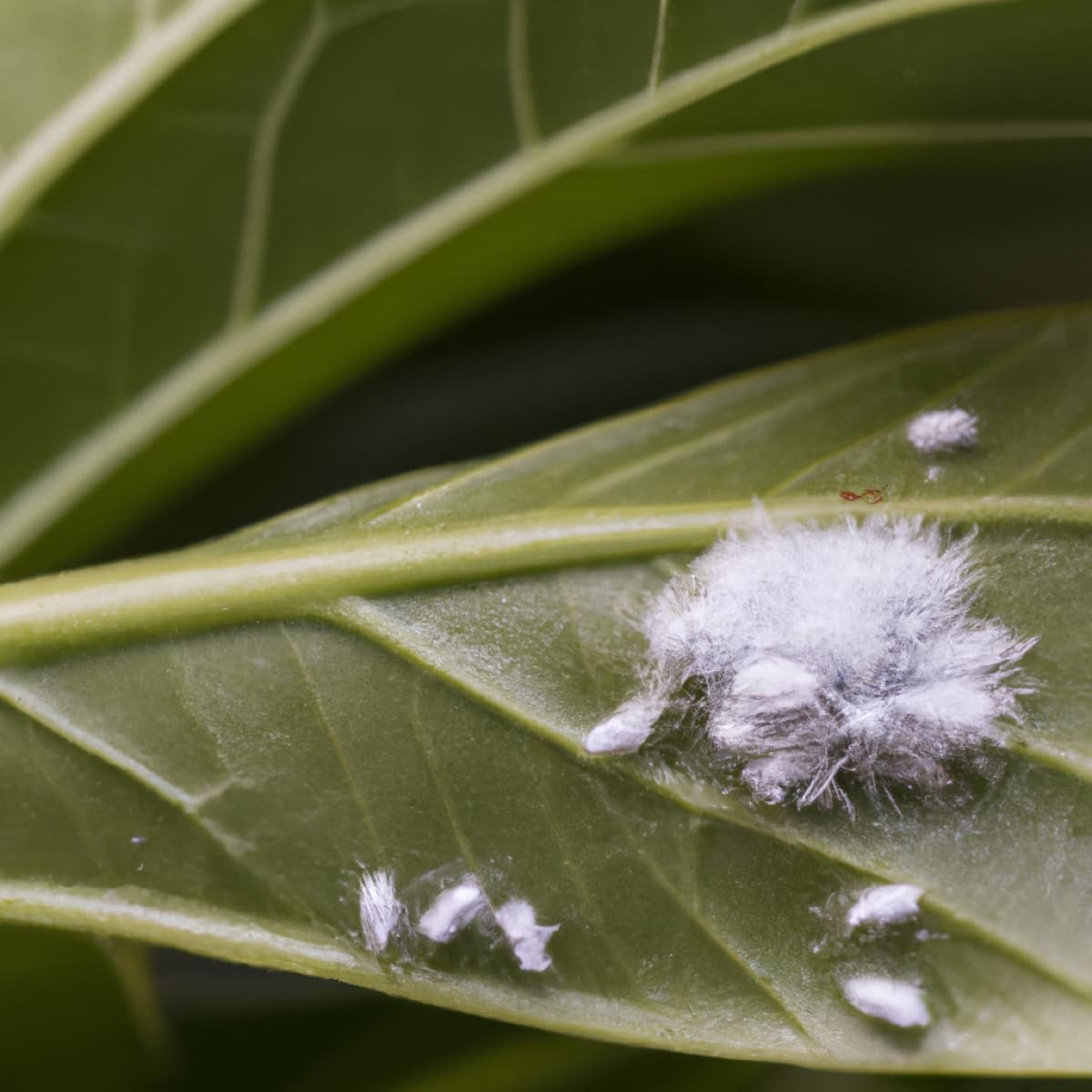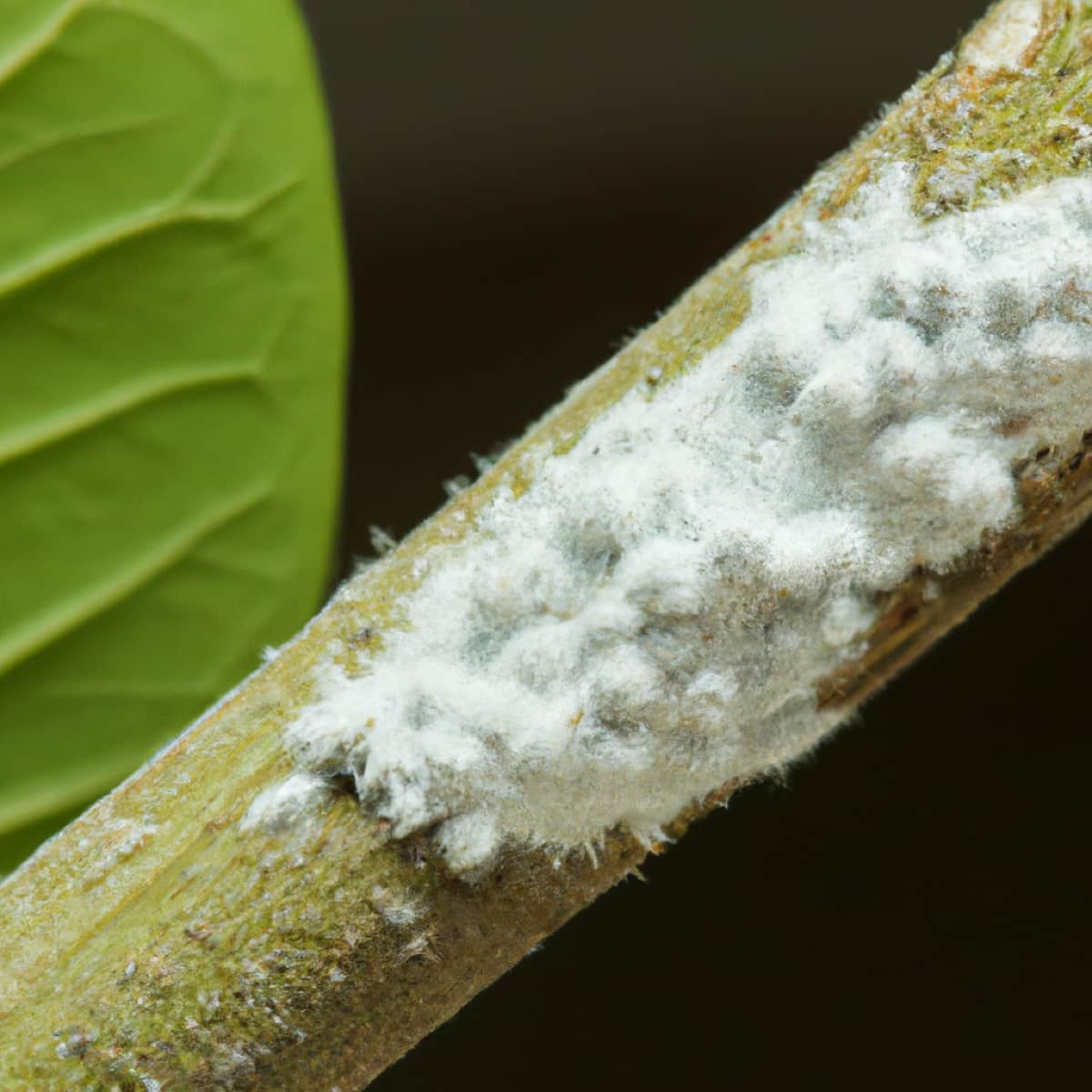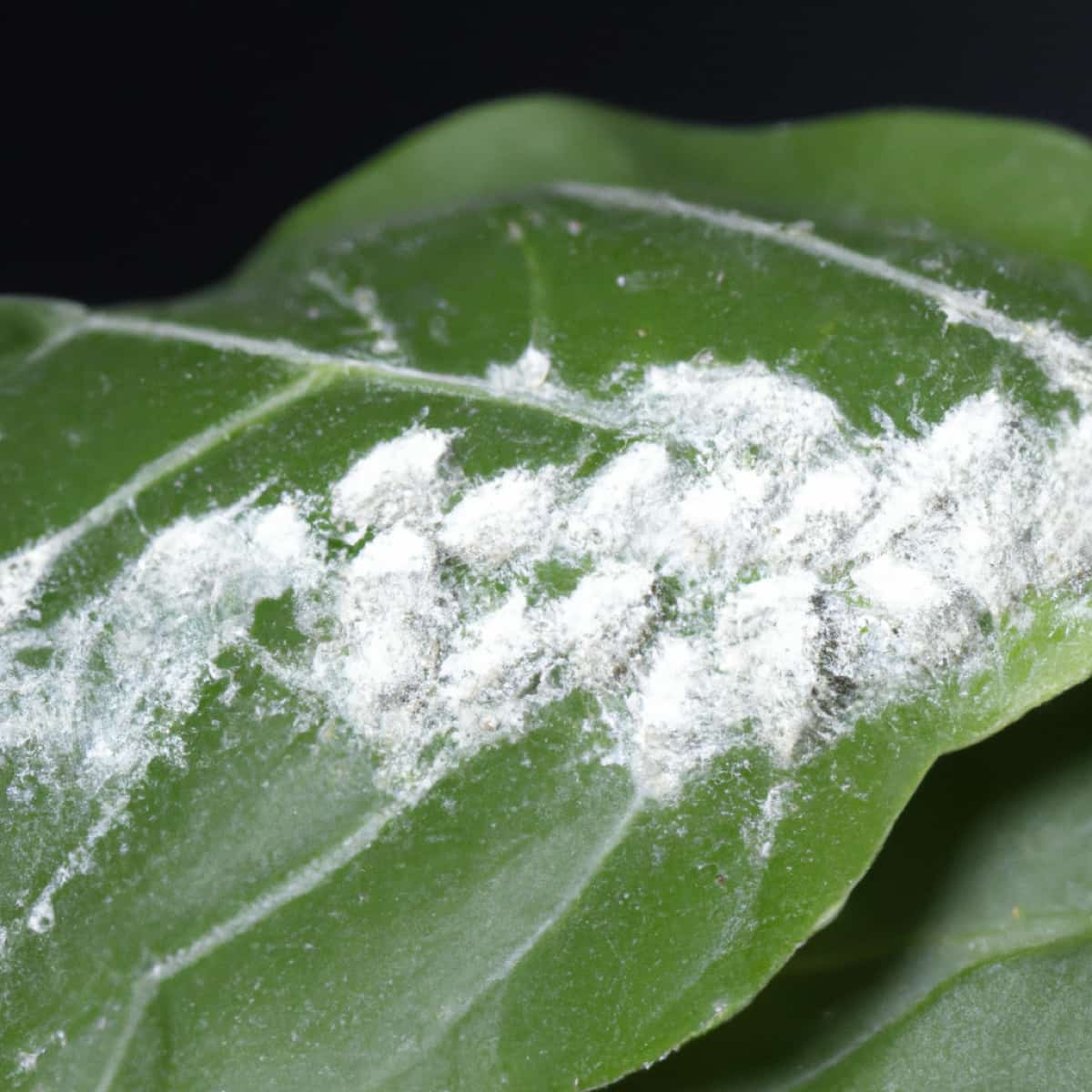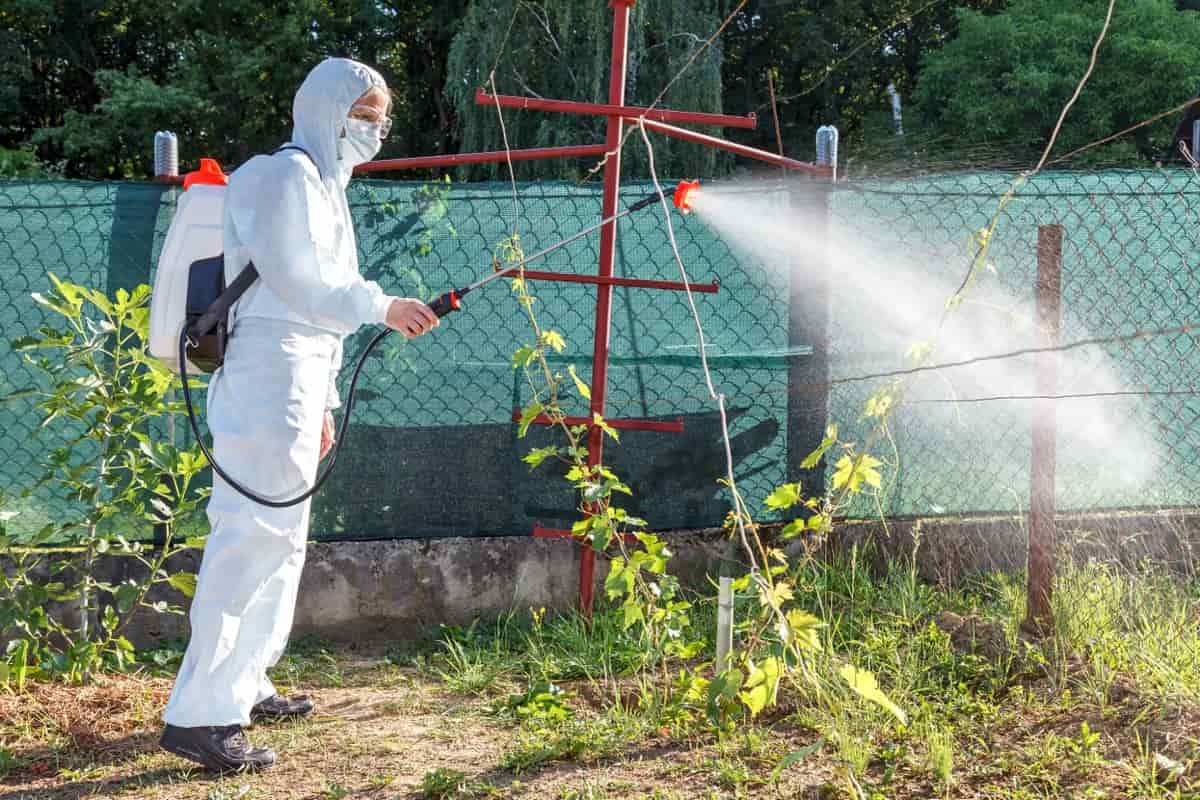Mealybugs are a common pest that infests a variety of plants, causing leaf damage, decreased growth, and wilting. Mealybugs, often known as woolly aphids, are little white insects that live in warm, moist environments on plants. They release a sticky substance called honeydew, which can attract ants and cause sooty mold to grow on the leaves. Let’s check out how to get rid of Mealybugs on plants.

Mealybugs are small, white, fluffy-looking insects found in clusters on the leaves, stems, and other parts of the plant. They have a life cycle of 1-3 months, with several generations occurring each year. They tend to congregate in moist and protected parts of the plant and are often carried about by ants, which will farm them for the honeydew they produce. If left untreated, mealybug infestations can quickly build up and cause severe damage to plants.
Identifying mealybugs on plants is essential for effective pest control methods. Knowing their life cycle and behavior can help you find the most effective treatment option for your plants. In this article, we will discuss what mealybugs are, their life cycle, how to identify them on plants, tips on how to get rid of them using home remedies, and what to look for when monitoring an infestation of mealybugs.
How to get rid of Mealybugs on plants
What are Mealybugs?
Mealybugs are small, sap-sucking insects that belong to the family Pseudococcidae. They are known for their waxy, mealy appearance. They can be found on a variety of plants, including indoor and outdoor foliage and succulents. Mealybugs can cause damage to plants by feeding on their sap, which can lead to yellowing leaves, wilting, and stunted growth. They can also produce a sticky honeydew substance that can attract ants and promote the growth of sooty mold. They can be controlled through insecticides, horticultural oil, or by physically removing them from the plant.
What do Mealybugs look like?
Mealybugs are small, spongy insects that feed on plants, often causing damage to foliage and flowers. Mealybugs can vary in appearance depending on their species. Still, they typically appear as oval-shaped insects with a white, waxy coating. They range in size from 1/20 of an inch to over 1/8 of an inch in length. Mealybugs may also have antennae and a pair of short tail filaments that look like tiny tails sticking out from their bodies.
In case you missed it: How to Get Rid of Bugs on Indoor Plants: Simple Tips, Ideas, and Techniques

Where do Mealybugs come from?
Mealybugs are native to tropical and subtropical regions. Still, they have been introduced to other parts of the world through the movement of plants and other agricultural products. They are often found in warm, moist climates and can cause significant damage to plants and crops.
They are particularly fond of warm, humid environments and can thrive in greenhouses and other controlled environments. Some species of mealybugs can also infest structures like homes, commercial buildings, and museums, where they can feed on indoor plants, woodwork, and other materials.
How do Mealybugs damage plants?
Mealybugs damage plants by feeding on their sap, the plant’s vital fluid that carries nutrients and water throughout the plant. This sap-sucking can cause yellowing leaves, wilting, and stunted growth. Mealybugs produce a sticky substance called honeydew, which can attract ants and promote the growth of sooty mold.
This mold can cover the leaves and stem of the plant, blocking sunlight and making it difficult to photosynthesize. In large infestations, mealybugs can cause severe damage to the plant and even kill it. They can also weaken the plant’s immune system, making more susceptible to other pests and diseases. Mealybugs also reproduce quickly, which can make controlling an infestation difficult.
The life cycle of Mealybugs
- Egg: Mealybugs lay their eggs in clusters on leaves, stems, or other parts of the plant. The eggs are small, oval-shaped, and white.
- Nymph: After hatching, the eggs develop into nymphs. Nymphs resemble small adults and are also covered in white, powdery wax. They go through several instars (stages) before reaching maturity.
- Adult: Fully grown mealybugs are about 3 millimeters long and covered in white, powdery wax. They have two pairs of wings but are not able to fly.
- Reproduction: Adult mealybugs reproduce sexually, with females laying eggs and males fertilizing them. Some species of mealybugs can also reproduce asexually.
In case you missed it: Best Ways to Get Rid of Thrips on Plants: Naturally, Organically for Indoors and Outdoors

How to identify Mealybugs on plants?
Mealybugs are small, white, fluffy-looking insects that can infest a variety of plants. They are often found in clusters on the leaves, stems, and other parts of the plant. To identify mealybugs on your plants, look for the following signs:
- White, cottony masses: Mealybugs are often found in clusters and are covered in white, powdery wax. They can be found on leaves, stems, and even the roots of plants.
- Yellowing or wilting leaves: Mealybugs feed on the sap of plants, which can cause leaves to yellow or wilt.
- Stickiness on leaves or stems: Mealybugs excrete a sticky material called honeydew, which can attract ants and cause sooty mold to grow on the leaves.
- Distorted or stunted growth: Heavy infestations can cause distorted or stunted growth in plants.
- Mealybugs themselves: Look for small, white, fluffy insects on the plant. They are about 3 millimeters long and can be found on all parts of the plant.
In case you missed it: How to Identify and Control Whiteflies in Home Garden: How to Get Rid of Them Naturally

Plants that attract Mealybugs
- Citrus plants: Mealybugs are particularly attracted to citrus plants such as oranges, lemons, and limes.
- Succulents: Cactus and agave are also prone to mealybug infestations.
- Houseplants: Many houseplants, such as ficus, hibiscus, and African violets, can be susceptible to mealybugs.
- Fruit trees: Mealybugs can also be found on fruit trees such as apples, peaches, and plums.
- Ornamental plants: Many ornamental plants, such as roses, camellias, and hollyhocks, can also be affected by mealybugs.
How to control, manage, kill and get rid of Mealybugs
- Spraying water at top speed: Spraying water at full force on the plants is an easy technique to get rid of mealybugs early. The bugs will fall off the plant as a result of this.
- Wiping away mealybugs with a moist cloth is another simple option. Take a clean towel, moisten it, wring it out, and use it to wipe all the leaves, top and bottom gently.
- Spray soapy water on affected plants by combining one tablespoon of dishwashing soap with one pint of warm water. The soap will kill the bugs by penetrating the wax layer.
- Rub Isopropyl Ethanol: Isopropyl alcohol is quite good at killing mealybugs. Please take a couple of cotton swabs, dip them in alcohol, and clean the affected area of the plant.
- Spray a soap, alcohol, and water mixture: To make an even more effective mixture, combine alcohol, liquid soap, and water. Make one and a half liter of the mixture by combining water and alcohol. Spray on the affected plants after adding one tablespoon of liquid soap to the mixture.
- Apply just little oil: Oil is also known to help with mealybug control on plants. Insects suffocate and perish as a result of the thick oil.
- Use natural predators: Mealybugs can also be controlled by predators such as ladybirds, spiders, lacewings, and so on.
- Other natural remedies: You can also use garlic, vinegar, and a spicy sauce. Similarly, spray the plant with jalapeno juice or a mixture of cayenne pepper, hot water, and Tabasco sauce. All of these mixtures act as natural pesticides. You can also use Murphy’s oil soap in conjunction with water.
Non-chemical methods for controlling Mealybugs
- Handpicking the bugs and destroying them.
- Applying sticky bands on the main stem or bark to prevent crawlers from reaching the top of the plant.
- In Mango and Guava crops, wrapping the trunk with a 400 gauge alkathene sheet or a 25 cm wide grease band at 30 cm above the ground prevents juvenile Mealybugs from reaching the plant and thereby minimizes infestation.
Organic methods for controlling Mealybugs
- Eco-neem and eco-oil are organic insecticides that can control and eliminate mealybugs on plants. These oils suffocate the mealybugs and can be applied directly to the infested areas. It’s important to ensure the spray gets into the crevices and leaf folds where mealybugs congregate. A follow-up spray is usually required a week later.
- Organic insecticidal soaps are a popular method for controlling mealybugs, as they are effective at killing the bugs while being safe for use on plants. These soaps work by disrupting the insects’ cell membranes, which causes them to dehydrate and die.
- Releasing the Mealybug predator Cryptolaemus montrouzieri (Australian Ladybird beetle) at a rate of 1200 per acre is one way to manage Mealybug infestations. Another method uses fungal biological agents such as Verticillium lecanii and Beauveria bassiana. Additionally, Neem oil can be sprayed at a rate of 1500 ppm with 5-7 ml of water per liter of spray solution.
- Another important aspect is to control the ants, as they feed on the honeydew that the bugs produce, and protect them from getting a regular food supply. One way to do this is by applying a band of horticultural glue around the base of plant trunks to restrict their movements. It will prevent the ants from getting to the mealybugs and protect them.
- Companion planting: Some plants like marigolds, nasturtium, and chrysanthemum can repel mealybugs, so planting them near your infested plants can help keep them away.
- Biological control: Encourage natural predators such as ladybugs, lacewings, and parasitic wasps to control mealybugs.
- To get rid of mealybugs, a combination of methods can be used: -A strong blast of water to remove the bugs physically -Insecticidal soap spray or neem oil spray applied directly to the bugs -Introducing natural predators like ladybugs or parasitic wasps as biological control method -Maintaining healthy plants and regularly inspecting them for signs of infestation to prevent outbreaks.
- Neem oil can be effective in controlling mealybugs. It disrupts the bugs’ feeding and reproduction and repels them from returning to the treated plants. However, it’s important to use a pure neem oil product labeled for use on plants and follow the product’s instructions for safe and effective use.
In case you missed it: How to Get Rid Of Spider Mites On Indoor Plants

It’s important to note that, to be effective, these methods should be applied as soon as you spot an infestation and repeated as necessary. Regular monitoring of the plants is also important to catch an infestation early.
Chemical methods for controlling Mealybugs
- Buprofezin 25.00% SC: This insecticide can be sprayed at 2ml/lt of water.
- Dimethoate 30.00% EC: This insecticide can be sprayed at a rate of 5ml/lt of water.
- Methomyl 40.00% SP: This insecticide can be sprayed at a rate of 2ml/lt of water.
- Buprofezin 20.00%+Acephate 50.00% w/w WP: This insecticide can be sprayed at a rate of 2.5 gm/lt of water.
- Rubbing alcohol can kill mealybugs instantly when applied directly to the bugs with a cotton swab.
It’s important to note that before using any chemical insecticides, it’s crucial to read and follow the instructions on the product label. Also, it’s important to note that chemical insecticides cause harm to beneficial insects, so it’s best to use them as a last resort and in combination with other methods.
In case you missed it: Ways to Keep Ants Away from Your Garden Plants: Tips for Natural Control, Ideas to Get Rid

Conclusion
Home remedies such as a strong blast of water, rubbing alcohol applied directly to the bugs, or neem oil spray can effectively manage small infestations. For more extensive problems, consider using integrated pest management (IPM) techniques, such as introducing natural predators or using organic insecticidal soaps.
Additionally, maintaining healthy plants and regularly inspecting them for signs of infestation can help prevent mealybug outbreaks. It’s essential to keep in mind that it is always recommended to use organic methods before chemical ones to avoid harmful effects on nature, also, always follow the instructions of the product you are using and be aware of the consequences of overuse.
- Flower Garden Designs and Layouts for Beginners
- Planting and Spacing Techniques in Papaya: A Beginner’s Guide
- Growing Gold: Essential Techniques for Planting Pineapples
- How to Make Kalanchoe Plant Bushy: Home Remedies and Solutions
- 11 Reasons Why Your Gardenia is Not Blooming: Home Remedies and Solutions
- Eco Elegance: The Guide to Designing a Drought-Tolerant Landscape
- Gardening on a Slope: Strategies for Hillside Landscaping
- Nourish and Flourish: Top Organic Mulches for Thriving House Plants
- Everything You Want to Know about Indian Mogra Flower: Discover Uses and Growing
- Green Thumb Success: Expert Tips for Cultivating Greenhouse Pumpkins All Year Round
- Maximize Growth & Flavor: The Ultimate Guide to Companion Planting in Herb Gardens
- How to Control Rhododendron Problems Naturally: Home Remedies and Organic Ways to Fix Them
- Natural Magic: The Remarkable Benefits of Cinnamon for Plants
- Best Steps to Revive Dying Tulip with Natural and Organic Treatment
- 10 Reasons Why Your Angel Trumpet is Not Blooming: Remedies and Treatment
- How to Fix Periwinkle Leaf and Flower-Related Problems: Natural Remedies and Solutions
- How to Fix Zinnias Leaf and Flower Problems: Discover Natural and Home Remedies
- Organic Steps to Induce Lemon Tree Flowers: A Comprehensive Guide
- Bloom Booster: Crafting the Perfect Homemade Bougainvillea Fertilizer
- Optimizing Growth: A Guide to Applying NPK Fertilizer for Potted Plants
- 10 Best Homemade Fertilizers for Rubber Plant: DIY Recipes and Application Method
- How to Boost Female Pumpkin Flowers: Effective Steps for More Flowers and High Yields
- Transform Your Indoor Garden: Top Benefits of Pink Salt for Houseplants
- 10 Best Homemade Fertilizers for Peacock Plants (Calathea): Easy DIY Guide
- Unlock Blooms: 9 Reasons Why Your Potted Chrysanthemum is Not Blooming
- 8 Reasons Why Your Potted Hibiscus is Not Blooming: Fix it with Simple Solutions
- Unlock Blooms: 9 Key Reasons Your Potted Frangipani Won’t Flower
- 10 Reasons Why Is My Ice Plant Not Blooming: Remedies and Treatment
- 10 Reasons Why My Potted Hydrangea Not Blooming: Treatment and Remedies
- 10 Reasons Why is My Wisteria Not Blooming: Remedies and Treatment
- 10 Reasons Why is My Goldfish Plant Not Blooming: Remedies and Treatment
- Maximize Your Space: Ultimate Guide to Balcony Gardening with Grow Bags
- 10 Reasons Why Your Iris is Not Blooming: Remedies and Treatment
- 10 Reasons Why Your Anthurium Plant is Not Blooming: Treatment and Remedies
- 10 Reasons Why Your Aquaponic Plants Are Not Flowering: Remedies and Treatment
- 10 Reasons Why Your Agapanthus is Not Flowering: Remedies and Treatment